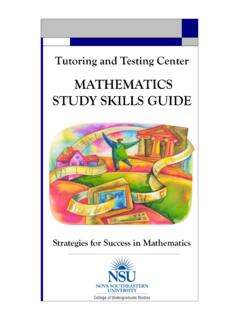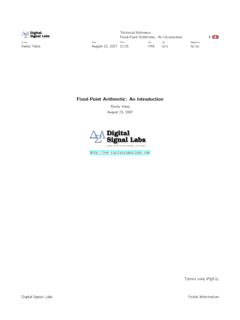Transcription of The Mathematics of the Rubik’s Cube - Massachusetts …
1 The Mathematics of the Rubik s CubeIntroduction to Group Theory and Permutation PuzzlesMarch 17, 2009 IntroductionAlmost everyone has tried to solve a Rubik s cube . The first attempt oftenends in vain with only a jumbled mess of colored cubies (as I will call onesmall cube in the bigger Rubik s cube ) in no coherent order. Solving the cubebecomes almost trivial once a certain core set of algorithms, called macros,are learned. Using basic group theory, the reason these solutions are notincredibly difficult to find will become this discussion, we will use the following notation to refer to thesides of the cube :Front FRight RDown DUpULeft LBack Mathematics of the Rubik s CubeThe same notation will be used to refer to face rotations. Forexample, Fmeans to rotate the front face 90 degrees clockwise. A counterclockwise ro-tation is denoted by lowercase letters (f) or by adding a (F ).
2 A 180 degreeturn is denoted by adding a superscript 2 (F2), or just the move followed bya 2 (F2).To refer to an individual cubie or a face of a cubie, we use one letter forthe center cubies, two letters for the edge cubies, and threeletters for thecorner cubies, which give the faces of the cube that the cubieis part of. Thefirst of the three letters gives the side of the cubie we are referring to. Forexample, in the picture below, the red square is at FUR, yellow at RUF, blueat URF, and green at ULB:Bounds on Solving a Rubik s CubeThe number of possible permutations of the squares on a Rubik s cube seemsdaunting. There are 8 corner pieces that can be arranged in 8!ways, eachof which can be arranged in 3 orientations, giving 38possibilities for eachpermutation of the corner pieces. There are 12 edge pieces which can bearranged in 12!
3 Ways. Each edge piece has 2 possible orientations, so eachpermutation of edge pieces has 212arrangements. But in the Rubik s cube ,only13of the permutations have the rotations of the corner cubies the permutations have the same edge-flipping orientationas theoriginal cube , and only12of these have the correct cubie-rearrangement par-ity, which will be discussed later. This gives:(8! 38 12! 212)(3 2 2)= Mathematics of the Rubik s Cubepossible arrangements of the Rubik s is not completely known how to find the minimum distance between twoarrangements of the cube . Of particular interest is the minimum number ofmoves from any permutation of the cube s cubies back to the initial important question is the worst possible jumbling of the cube , thatis, the arrangement requiring the maximum number of minimumsteps backto the solved state.
4 This number is referred to as God s number , and hasbeen shown (only as recently as August 12 this year) to be as low as lower bound on God s number is known. Since the first twistof a facecan happen 12 ways (there are 6 faces, each of which can be rotated in 2possible directions), and the move after that can twist another face in 11ways (since one of the 12 undoes the first move), we can find bounds on theworst possible number of moves away from the start state withthe following pidgeonhole inequality ( number of possible outcomes of rearranging mustbe greater than or equal to the number of permutations of the cube ):12 11n 1 1019which is solved byn solution mathod we will use in class won t ever go over 100moves or so,but the fastest speedcubers use about definition, agroupGconsists of a set of objects and a binary operator,*, on those objects satisfying the following four conditions: The operation * is closed, so for any group elementshandginG,h gis also , Tom.
5 Twenty-Two Moves Suffice . 12, Mathematics of the Rubik s cube The operation * is associative, so for any elementsf, g,andh, (f g) h=f (g h). There is an identity elemente Gsuch thate g=g e=g. Every element inGhas an inverseg 1relative to the operation * suchthatg g 1=g 1 g= that one of the requirements isnotcommutativity, and it will soonbecome clear why this is not About GroupsKeep in mind the following basic theorems about groups: The identity element,e, is unique. Ifa b=e, thena=b 1 Ifa x=b x, thena=b The inverse of (ab) isb 1a 1 (a 1) 1=eExamples of GroupsThe following are some of the many examples of groups you probably useeveryday: The integers form a group under addition. The identity lement is 0,and the inverse of any integerais its negative , a. The nonzero rational numbers form a group under multiplication. Theidentity element is 1, and the inverse of anyxis1x.
6 The set ofn nnon-singular matrices form a group under multiplica-tion. This is an example of a non-commutative group, ornon-abeliangroup, as will be the Rubik Mathematics of the Rubik s CubeCube Moves as Group ElementsWe can conveniently represent cube permutations as group elements. Wewill call the group of permutationsR, for Rubik (not to be confused withthe symbol for real numbers).The Binary Operator for the Rubik GroupOur binary operator, *, will be a concatenation of sequencesof cube moves, orrotations of a face of the cube . We will almost always omit the* symbol, andinterpretf gasf g. This operation is clearly closed, since any face rotationstill leaves us with a permutation of the cube , which is inR. Rotationsare also associative: it does not matter how we group them, aslong as theorder in which operations are performed is conserved.
7 The identity elementecorresponds to not changing the cube at inverse of a group elementgis usually written asg 1. We saw abovethat ifgandhare two elements of a group, then (hg) 1=g 1h 1. If wethink of multiplying something by a group element as an operation on thatthing, then the reversed order of the elements in the inverseshould makesense. Think of putting on your shoes and socks: to put them on, you puton your socks first, then your shoes. But to take them off you must reversethe the cube move that rotates the front face clockwise. Thenf,the inverse ofF, moves the front face counterclockwise. Suppose there isa sequence of moves, sayF R, then the inverse ofF Risrf: to invert theoperations they must be done in reverse order. So the inverseof an elementessentially undoes different move sequences of cube elements can be viewed aspermuta-tions, or rearrangements, of the cubies.
8 Note move sequences that Mathematics of the Rubik s Cubethe same cube configuration are seen to be the same element of the group ofpermutations. So every move can be written as a example ,the moveF F RRis the same as the permutation (DF UF)(DR UR)(BR FRFL)(DBR UFR DFL)(ULF URB DRF).It is easier to discuss these permutations first using numbers. An example ofa permutation written incanonical cycle notationis:(1)(234)This means that 1 stays in place, and elements 2, 3, and 4 are cycled. Forexample, 2 goes to 3, 3 goes to 4, and 4 goes to 2. (234) (423).The steps in writing down combinations of permutations in canonical cyclenotation are as follows:1. Find the smallest item in the list, and begin a cycle with it. In thisexample, we start with Complete the first cycle by following the movements of the objectsthrough the permutation.
9 Do this until you close the cycle. For in-stance, in (1 2 4)(3 5) * (6 1 2)(3 4), we start with 1. 1 moves to 2inthe first permutation, and 2 moves to 6 in the second, so 1 movesto 6 shows that it moves back to 1, so 6 and 1 form one If you have used up all the numbers, you are done. If not, return to step1 to start a new cycle with the smallest unused element. Continuing inthis manner gives (1 6)(2 3 5 4).IfPconsists of multiple cycles of varying length, then theorderof thatpermutation isn, since applyingP ntimes returns the beginning state. IfPconsists of multiple cycles of varying length, then the order is the least com-mon multiple of the lengths of the cycles, since that number of cycle stepswill return both chains to their starting states. Below are several examples:(1 2 3)(2 3 1) = (1 3 2) order 3(2 3)(4 5 6)(3 4 5) = (2 4 3)(5 6) order 6(1 2) order Mathematics of the Rubik s CubeParityPermutations can also be described in terms of their lengthncycle of a permutation can be expressed as the product of yourself that this is true, look at the following examples:(1 2) = (1 2)(1 2 3) = (1 2)(1 3)(1 2 3 4) = (1 2)(1 3)(1 4)(1 2 3 4 5) = (1 2)(1 3)(1 4)(1 5)The pattern continues for any length the parity of a lengthncycle is given by the number 2 cycles it iscomposed of.
10 Ifnis even, an odd number of 2-cycles is required, and thepermutation is odd, and vise versa. So odd permutations end up exchangingan odd number of cubies, and even ones an even we will prove an important fact about cube parity that will help ussolve the cube later:Theorem: The cube always has even parity, or an even number ofcubiesexchanged from the starting (by induction on the number of face rotations,n):Base Case: Aftern= 0 moves on an unsolved cube , there are no cubiesexchanged, and 0 is (n) : afternrotations, there are an even number of cubies assumeP(n) to showP(n) P(n+ 1). Any sequence of moves is com-posed of single face turns. As an example of the permutation created by aface turn, look at the moveF= (FL FU FR FD)(FUL FUR FDR FDL)= (FL FU)(FL FR)(FL FD)(FUL FUR)(FUL FDR)(FUL FDL). Since eachof the length 4 chains in this permutation can be written as 3 2-cycles for atotal of 6 2-cycles, the parity of the face turn is even.












